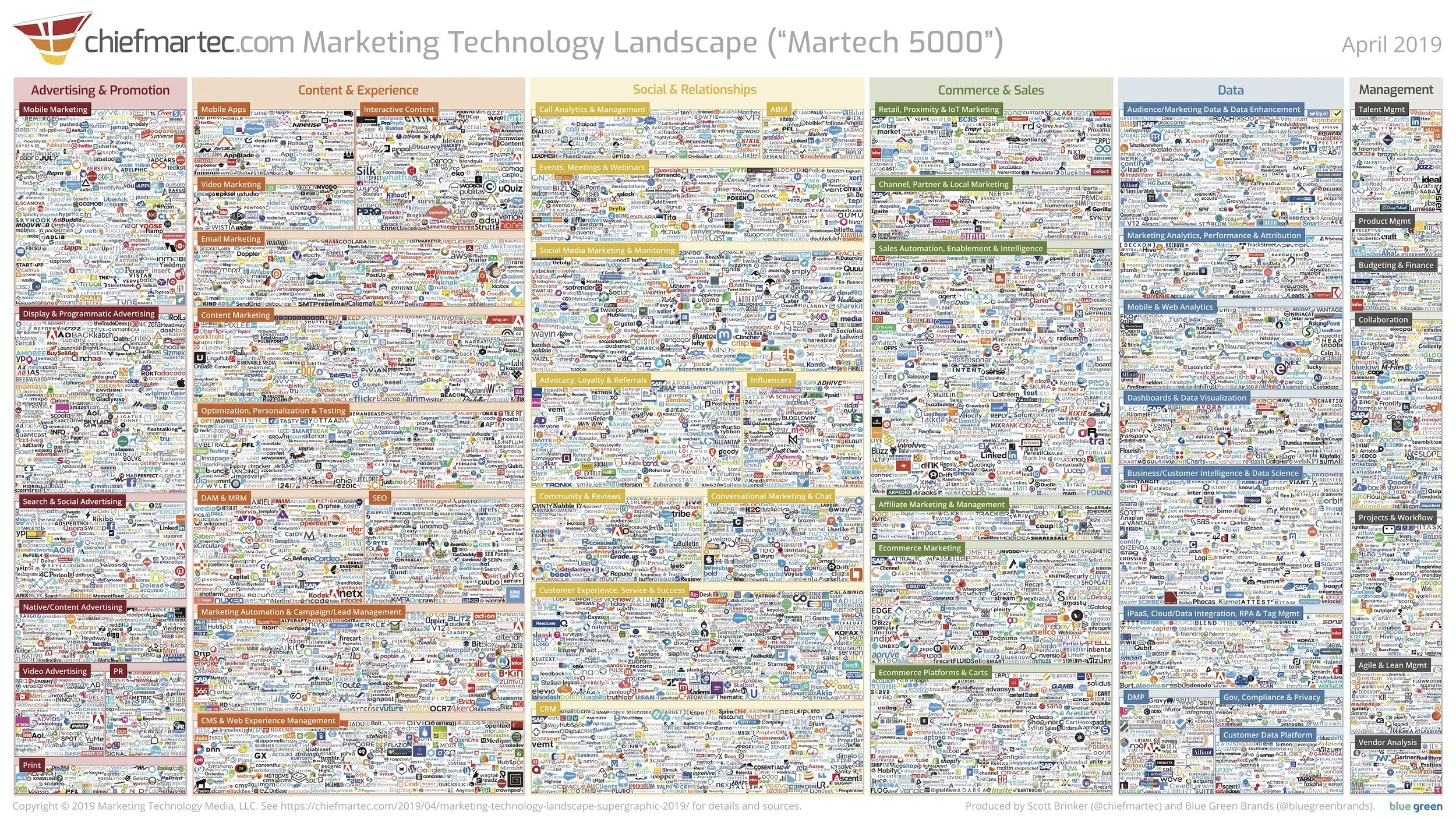How Clear and Compelling Is Your Story?
3 Ways to Test Your Messaging and 3 Tools to Tighten It Up
Shout It Out — Photo by Jason Rosewell on Unsplash
This blog post was originally published on Medium.com on October 14th, 2019
——
“The future is already here — it’s just not evenly distributed yet.”
If you’re a startup founder or leader, chances are this quote will ring true to you.
The product or service you are building, crafting, and bringing into the world is the future.
Now if only more of my potential customers knew about it!
Unfortunately, it’s a noisy world.
Just look at how much of the future is being built in the form of software for just sales and marketing teams to use (that is 6850 different logos to be clear):
So what can you do to stand out in this world where the new normal is so noisy?
With a clear & compelling story that’s easy to understand and easy to repeat.
Here’s 3 ways to test out your current story and 3 tools to help you tighten it up.
—
1. 10-Second Website Test
Donald Miller from StoryBrand likes to call this the grunt test.
Can someone that doesn’t know you or your company look at your website for 10 seconds and then slam the laptop shut or flip the phone over and tell you what you do and who you do it for?
Test It Out: Go work from a nearby coffee shop or co-working space and pick a few people to help you out for 30 seconds to take your 10 Second Website Test.
Pull up your website and let them look at it for up to 10 seconds. Then close your laptop and ask them what you do and who you do it for.
Bonus points if they can say why someone would want to buy your product or service.
If after closing your laptop they can’t communicate close to what you hope they can take away in 10-seconds, you know you have some room to improve.
Tool to Hone It In — One of the most impactful exercises I use when I facilitate Story Sprints for founders is leading clients through a 3x3 Walkthrough by Tom Cavill.
Using this framework you can boil down your messaging to one sentence using 9 core key words:
3 words for What Your Product or Service Does
3 words for Why Someone Wants to Buy Your Product(Main Benefit or Value Proposition)
3 words for How You Do/Offer Your Product or Service Differently Than Your Competitor (aka your “Secret Sauce”)
Here’s a real client example: 1Huddle offers a Workforce Training App that gets your employees Ready to Work Faster through Customized Quick-Burst Games.
2. The Employee Challenge
“So… what do you do?”
It’s the #1 question asked by two people meeting for the first time, especially in any type of business setting.
Every networking event you attend, every time you’re introduced to a friend of a friend, meeting a new parent at your kid’s school, striking up a conversation with the person next to you at the coffee shop or co-working space, or say at a conference you’re attending.
Do you have a short, concise go-to response to this question?
Or does your answer sound something more like one of these:
“Well I own an agency that does a few things… um… one thing is … well we do marketing and …uh we also do video…stuff… and I guess we do some social media stuff too… and actually we are great at websites… and if you need any Google ads we can do that for you!”
“Hmmm it’s kind of complicated… I co-founded a software company and we do stuff most people don’t really understand…it’s all in the background helping other companies with their supply chain efficiency using AI and big data…”
“Our company provides integrated solutions to global brands. We use proprietary algorithms to find opportunities in their sales outreach and marketing departments to create synergies and leverage the data to create unique value for their end customers.”
“I work in marketing for a great startup, XYZ , and we help other companies automate boring stuff like their benefits and payroll, but it’s a super fun company to work for and we have a killer office space downtown with two IPAs on tap! And by the way we’re growing fast and hiring!”
Test It Out: Ask your employees 1–1 how they answer the “What do you do?” question. How many different variations do you get? 3, 10, 100?
If you really want to have some fun with it, take it a step further and call up your spouse or significant other, your best friend, and your mom and poll them on how they would describe it.
Can any of them give a concise and compelling message or brand story for your company?
Tool to Hone It In: Storyteller and Founder of Stick.ai, Alli McKee
shares a great breakdown on how Warby Parker tells their brand story in 100 words right on their cleaning cloth, something you might use every day.
Along with the one core sentence from the 3x3 in #1, having a little bit longer version of your brand story that can still be given concisely in 30 seconds is a great tool to have everyone in the company confidently answering the “What do you do?” question.
The core parts of a 30-second or 100 word story are:
the current problem you’ve identified (that people should nod their head to when they hear it)
your new unique solution/offering for that problem
what success looks like with your product/service.
Here’s a real client example:
“If we know one thing is for certain, mobile content consumption is only going to grow.
Which means if you’ve built an audience online through news or engaging content on a Wordpress based website, you better have a solution to serving your users where they look first and where they get their breaking news: their mobile phone.
Thankfully MobiLoud has cracked the code on successfully building native apps for publishers through their done-for-you service.
Whether it’s new monetization opportunities, push notifications, or the increased brand presence, an app from MobiLoud allows publishers to offer a better customer experience without adding to their development team.”
3. In Your Customer’s Own Words
Whoever gets closest to the customer wins.
It’s true for messaging and storytelling too.
One of the best ways to get more new customers using your product or service is to interview your current customers and use their own words in your messaging and content marketing.
If they were recommending you to a friend how would they say it?
What’s their definition of what/why/how your company does what you do?
Test It Out: Take your best customer out for lunch or dinner and ask them the above questions. Pay close attention to the exact words they use in how they would quickly introduce your company to a friend that might also need your product or service.
Is it clear?
Is it compelling?
Try your updated messaging on them (your 3x3) and ask them if they think it sounds right? If not, how would they change it? Ask them what the biggest impact from using your product/service has been on their business.
Tools to Hone It In: Here’s a treasure trove of links on how to do better customer research from the team at Google Ventures, of particular interest, is their finding that you really only need to test 5 users/customers to get a sweet spot of research.
Additionally here’s why customer verbatims are so important.
Real Client Example:
1Huddle is a workforce training platform that helps managers get employees ready to work through customized quick-burst games.
Here’s what one 1Huddle customer’s verbatim said about the difference 1Huddle brought to their team’s learning and development :
“The other learning platforms had no soul to them whatsoever.”
Notice how this is not something we probably would have come up with for the core story or messaging, but 1Huddle features it on their About page as a testimonial to help better paint the picture of the mission they are on — to help ensure people get the training they deserve to come ready to work and how that mission comes through the feeling of using the platform itself.
—
Consumer expectations have never been higher. You still have to deliver a great product with great customer service to win.
Those are table stakes.
But with a more clear and compelling story at your fingertips, on your website, in your sales deck, and used by your employees, friends, and family every time they tell someone about your company — you’ll get many more at-bats to deliver on that promise.
And soon the future that you are building will be more evenly distributed, and the world will be a better place for it.
—
Patrick Hodgdon is Founder and Chief Storyteller at Story Sprints, a 1/2 day workshop that brings startup Founders clarity through constraints using proven frameworks and design thinking exercises.
Ready to make sure you are telling a clear and compelling brand story?
Schedule a free 30-minute messaging audit with Patrick here.

